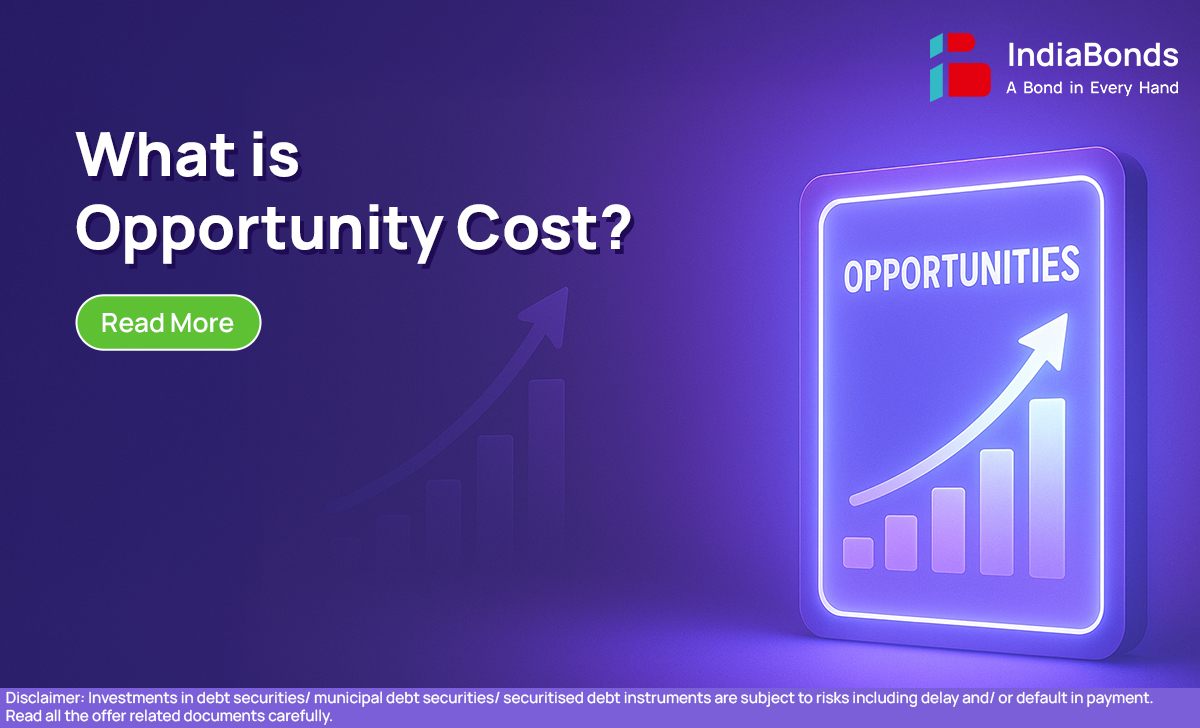What is Opportunity Cost?

Most of us make choices on instinct—FD or bond, study now or earn now, new phone or keep the savings. What we don’t see is the price of the option we leave behind. That quiet price has a name: opportunity cost. Once you spot it, your decisions change.
What Is Opportunity Cost?
So, what is opportunity cost in everyday language? It’s the value of the next best thing you could have done but didn’t. The opportunity cost meaning isn’t only rupees; it’s also time, comfort, even experiences. If you park cash in an FD, the higher returns from a quality corporate bond may become your opportunity cost. If you spend a weekend at a cousin’s wedding, the course you planned to finish gets pushed—again, opportunity cost. Put simply: every “yes” quietly cancels a second “yes.”
Formula for Calculating Opportunity Cost
There’s a neat way to put numbers to the idea:
Opportunity Cost = Return on Best Alternative – Return on Chosen Option
Let’s anchor this. Assume ₹1,00,000 goes into a 6% FD. The same money in a strong AA/AAA corporate bond could earn 10%. Pick the FD and the 4% gap is the opportunity cost. Notice, nothing “leaves” your account. You just didn’t capture the extra 4%. That’s why the opportunity cost definition is more like a lens than an entry in your passbook. It forces a small, honest pause before deciding: “If not this, what else could my money—or time—do for me right now?”
Opportunity Cost and Capital Structure
Companies live with opportunity cost daily. Raise equity and you avoid interest, but ownership dilutes. Take debt and you keep control, enjoy tax shields, but promise fixed repayments. When a company issues bonds instead of equity, it’s signalling that the opportunity cost of dilution feels higher than the cost of interest. As investors, reading these choices helps. You see how management values growth, control, and stability—by watching which alternative they refuse to give up.




Examples of Opportunity Costs
Real life is full of them. Below are Opportunity Costs Examples you’ll recognise:
- Education vs. Salary: The MBA student skips two years of earnings. That forgone income is opportunity cost—worth it if the degree lifts future cash flows.
- Government Choices: Allocate more to highways and less to hospitals; citizens gain speed but lose some health outcomes. Again, opportunity cost.
- Gold vs. Bonds: A family puts ₹5 lakh in gold for “safety.” If quality bonds pay 9%, the missed return is opportunity cost. Gold has its place; just see the trade-off.
- Sunday Trade-off: Netflix or a skill class? Rest has value; so does progress. Either way, opportunity cost sits in the background.
- Home Loan Prepayment: Prepaying saves interest. But if market yields are unusually attractive, the extra returns you could have earned elsewhere become your opportunity cost.
These Opportunity Costs Examples aren’t moral judgments. They’re simply a torch, showing what the other road might have offered.
Explicit vs. Implicit Costs
Explicit costs are visible: fees, rent, salaries—cash out. Implicit costs are quiet. Use savings to start a kirana? The interest that money could have earned in a deposit is an implicit cost. Opportunity cost blends both: the seen and the unseen. If you only tally explicit bills, choices look cleaner than they are. The fuller picture—explicit plus implicit—often nudges us toward better use of money, time, and even energy.
Opportunity Cost vs. Sunk Cost
Easy to confuse the two. Sunk cost is yesterday’s spend—gone. You bought a course last year and never opened it; that payment is sunk. Opportunity cost looks forward. If you attend the course tonight, you skip paid overtime; if you work, you skip the learning. The overtime or the upskilling you give up is the opportunity cost. Smart decision-making stops chasing sunk cost and weighs the future trade-off instead.
Opportunity Cost vs. Risk
Risk is uncertainty—maybe gains, maybe losses. Opportunity cost is certain—you know exactly what you’re not taking. Choose equities and face market swings (risk). Skip a 7% government bond to do so, and that assured 7% becomes your opportunity cost. Both matter. Risk asks, “What could happen to my chosen path?” Opportunity cost asks, “What did I forgo by not taking the other path?” Good portfolios respect both voices.
Conclusion
Once you notice opportunity cost, you can’t unsee it. It shows up in money choices, career moves, even how you spend an evening. The trick isn’t to chase every “best” option; it’s to choose with eyes open. With a clear view of the opportunity cost meaning, families plan better, businesses allocate better, and investors match products—FDs, government bonds, high-quality corporates—to real goals. Small pause, sharper choice.
FAQs
Q1. What is the simple definition of opportunity cost?
It’s the value of the next best alternative you gave up—time, money, or benefit. That’s the opportunity cost definition in one line.
Q2. Is opportunity cost always monetary?
No. You can measure opportunity cost in lost learning, lost rest, or a delayed goal, not just rupees.
Q3. Is opportunity cost the same as a trade-off?
A trade-off is the act of giving up one thing for another. Opportunity cost attaches value to the thing you didn’t pick.
Q4. How do businesses use opportunity cost?
They weigh projects, pricing, and financing. If a project ties up cash for three years, the opportunity cost is what that cash could have earned elsewhere with similar risk.
Q5. What is an example of opportunity cost in government?
Prioritising metro expansion over river clean-ups. The environmental gains forgone are the opportunity cost of that budget choice.
Disclaimer : Investments in debt securities/ municipal debt securities/ securitised debt instruments are subject to risks including delay and/ or default in payment. Read all the offer related documents carefully.



















































